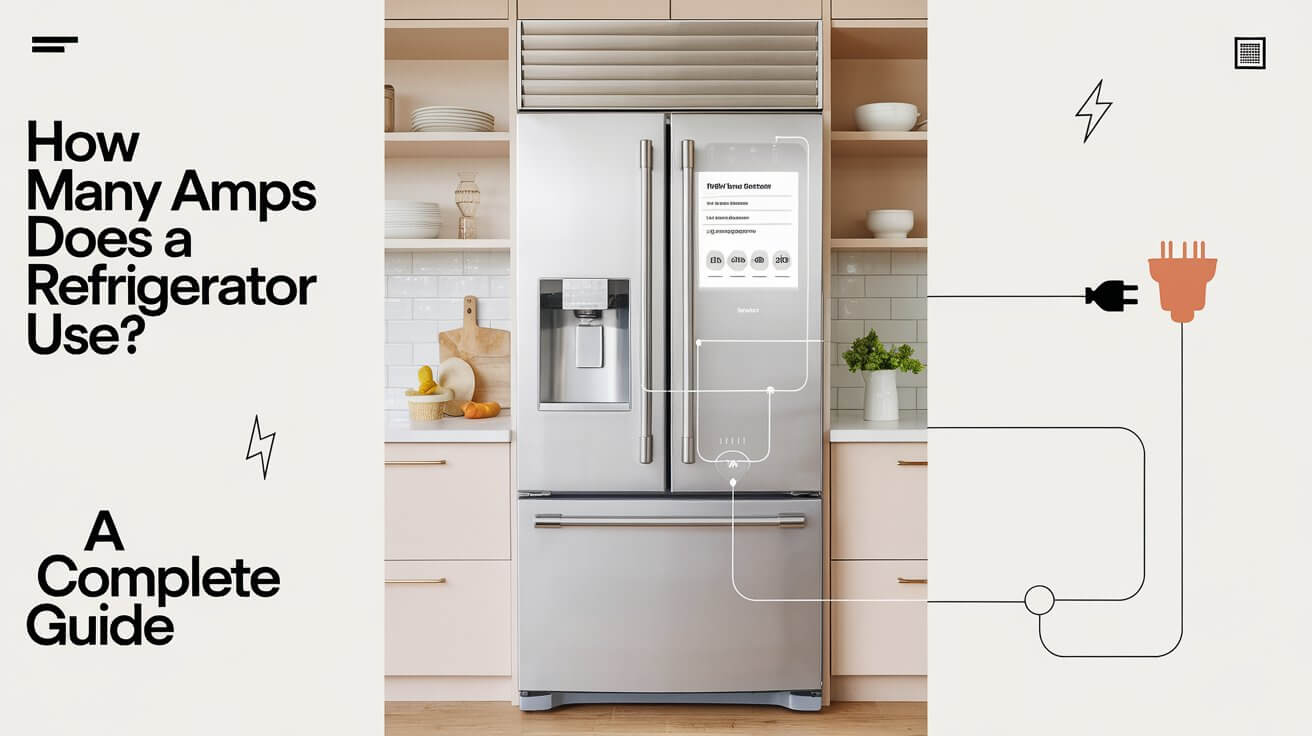How Many Amps Does a Refrigerator Use? A Complete Guide

Knowing how many amps a refrigerator uses is essential for maintaining energy efficiency, ensuring electrical safety, and planning household power loads. Generally, a standard refrigerator in the U.S. uses between 3 to 6 amps. However, the specific amp usage varies depending on factors like size, age, features, and even the refrigerator’s startup phase.
In this article, we’ll break down how to calculate amp usage, the factors that affect it, and everything else you need to know to manage your refrigerator’s power consumption.
What Is an Amp, and Why Does It Matter for Refrigerators?
Amps (short for amperes) are a unit of measurement for electrical current. They quantify how much electricity an appliance like a refrigerator draws from a power source.
Understanding amp usage matters because it directly impacts both energy consumption and the safety of your home’s electrical system. If a refrigerator draws too many amps, it can trip circuit breakers, blow fuses, or even damage the appliance.
Typical Amp Usage of a Refrigerator
Standard Refrigerators
Most standard home refrigerators use between 3 to 6 amps. This is based on a typical 120-volt electrical circuit, which is standard in most U.S. households. For instance, a fridge rated for 750 watts on a 120-volt line will draw about 6.25 amps (calculated as watts/volts = amps).
Newer, energy-efficient models tend to use the lower end of this range, often closer to 3 amps during regular operation. Older or larger models with additional features, such as ice makers or water dispensers, may push the amp usage closer to 6 amps.
Mini Refrigerators
A mini fridge typically uses less power than a full-sized model, often around 1.5 to 2 amps. Due to their smaller compressors and reduced cooling space, these models are a great option for dorms, offices, or small apartments where space and energy usage are a concern.
Large Refrigerators
Large refrigerators with advanced features (like side-by-side doors, multiple compartments, or smart technology) may use more than 6 amps, especially during startup. For example, a commercial refrigerator or one with a large freezer can draw 7 to 9 amps or more.
Amp Usage During Startup
When a refrigerator first kicks on, particularly when the compressor starts, it experiences a brief surge in power known as inrush current. This can cause a refrigerator to momentarily use 2 to 3 times its normal running amps.
For example, if your fridge normally uses 5 amps, it could surge to 10 to 15 amps for a few seconds during startup. This spike is important to consider because it can trip breakers, especially if other appliances are running on the same circuit.
Why Does This Spike Happen?
The surge occurs because the compressor and cooling fans require more power to begin operation. Once the compressor stabilizes, the amp usage drops back down to the normal running levels. This startup phase can last anywhere from a few seconds to a minute, depending on the refrigerator.
Factors That Affect Refrigerator Amp Usage
Size and Capacity
Larger refrigerators generally have bigger compressors and more space to cool, meaning they’ll draw more amps. A refrigerator designed to hold large amounts of food or with a high freezer-to-fridge ratio will consume more power than a smaller, single-compartment unit.
Type of Refrigerator
Certain types of refrigerators consume more electricity due to added features. For example:
- French-door models often use more amps because of their complex cooling systems.
- Smart refrigerators with Wi-Fi connectivity may draw more power due to extra electronic components.
- Side-by-side refrigerators tend to use more amps than top-freezer or bottom-freezer models because of larger surface areas to cool.
Age and Energy Efficiency
Older refrigerators are typically less energy-efficient than newer models, meaning they will draw more amps. Modern refrigerators are built with energy-saving technologies that reduce the overall power consumption without sacrificing performance. If your refrigerator is more than 10 years old, it might be drawing more amps than a new energy-efficient model would.
Temperature Settings and Usage
A refrigerator’s amp usage increases if it’s set to a lower temperature, as the cooling system has to work harder to maintain the cold environment. Additionally, frequently opening the refrigerator door or overstuffing it can also cause the compressor to run more often, increasing amp usage.
Environmental Conditions
Where you place your refrigerator also affects its amp usage:
- Hot environments make the fridge work harder to keep food cool, increasing the current draw.
- Poor ventilation around the refrigerator can trap heat and lead to increased amp usage.
- Dirty coils on the back of the refrigerator make it harder for the cooling system to expel heat, which also raises the amperage.
Do Refrigerators Require a Dedicated Circuit?
In most cases, yes. A refrigerator should have its own dedicated 15- or 20-amp circuit. This is important because refrigerators draw a considerable amount of power, especially during startup. Having a dedicated circuit ensures that the refrigerator doesn’t have to share power with other appliances, which could overload the circuit and trip the breaker.
What Happens If the Circuit Isn’t Dedicated?
If a refrigerator shares a circuit with other high-amp appliances like a microwave or dishwasher, it increases the risk of electrical problems:
- Tripped breakers: During the refrigerator’s startup surge, the additional draw could overload the circuit and trip the breaker.
- Blown fuses: If the wiring or fuse is too weak, the surge could cause a fuse to blow.
- Fire hazards: An overloaded circuit could cause overheating, leading to potential fire risks.
How to Calculate the Amps Your Refrigerator Uses
Calculating the amps your refrigerator uses is relatively simple if you know the wattage. Most refrigerators list their wattage on a label inside the door or on the back. Use this formula to find the amps:
Amps = Watts / Volts
For example, if your refrigerator is rated at 500 watts and runs on a 120-volt circuit:
500 watts / 120 volts = 4.17 amps
This means your refrigerator uses approximately 4.17 amps during normal operation.
How to Measure Refrigerator Amp Usage Directly
If you want a precise measurement of how many amps your refrigerator uses, you can use a clamp meter to measure the electrical current. Here’s how to do it:
- Turn off the power: Shut off the circuit breaker connected to the refrigerator.
- Clamp the meter: Place the clamp meter around one of the electrical wires connected to the refrigerator. Make sure you’re not touching any metal parts.
- Turn the power back on: Switch the circuit breaker back on, and the meter will display the current amps being drawn.
Important Safety Tip
While you can measure amp usage yourself, it’s always a good idea to have a licensed electrician handle electrical measurements if you’re not familiar with electrical work. Incorrect handling can lead to injury or damage to your appliances.
Can a Refrigerator Share a Circuit with Other Appliances?
While it’s technically possible for a refrigerator to share a circuit with other low-power appliances (like lights or small gadgets), it’s generally not recommended. High-power devices such as microwaves, dishwashers, and ovens should never share a circuit with a refrigerator.
Overloading the circuit can cause frequent tripping, which may damage your appliances and increase fire hazards.
Best Practices for Electrical Load Management
- Use dedicated circuits: For large appliances like refrigerators and freezers.
- Calculate total load: Ensure the total amps of appliances on a shared circuit don’t exceed 80% of the circuit’s capacity.
Energy-Saving Tips to Reduce Refrigerator Amp Usage
Regular Maintenance
- Clean the coils: Dusty or dirty coils make the refrigerator work harder, increasing its amp draw.
- Check the door seals: Poorly sealed doors let out cold air, causing the compressor to run more often.
Optimize Temperature Settings
Setting your refrigerator to the right temperature (35°F-38°F for the fridge and 0°F for the freezer) ensures optimal performance without overworking the compressor.
Upgrade to an Energy-Efficient Model
Modern refrigerators come with energy-saving features, such as smart thermostats and improved insulation, which can significantly reduce amp usage compared to older models. If your fridge is more than 10 years old, consider upgrading to a newer, more efficient model.
Conclusion
Understanding how many amps a refrigerator uses is crucial for energy management and electrical safety. A typical household refrigerator draws between 3 to 6 amps, but this can vary based on factors like size, age, and features. By calculating amp usage, maintaining your fridge, and ensuring it has a dedicated circuit, you can optimize both its efficiency and the safety of your home’s electrical system.
Keep your refrigerator running smoothly by following the best practices outlined in this guide, and you’ll avoid common electrical issues while saving on energy costs.



